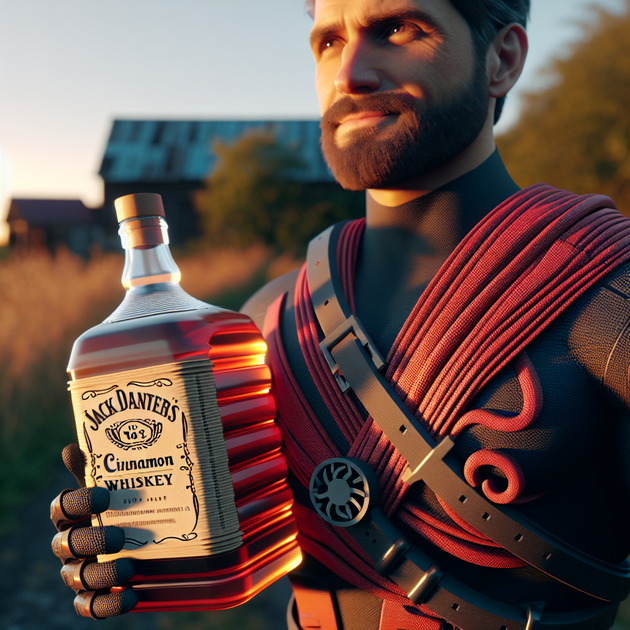You’ve got an upcoming barbecue or tailgate and want to bring your favorite cinnamon whiskey—without juggling it between conversations. Enter the Fireball Bandolier, a clever 3D-printed holster that keeps a full 1.5L bottle at your side like a utility tool. You can model, slice, and print it before dinner tonight.
Why the Fireball Bandolier Exists
The idea came from Reddit user MTW3ESQ, who posted their design on the r/functionalprint subreddit—a hub where hobbyists share prints that solve real-world problems instead of just looking cool. This one? It solves the “now where did I set my drink?” problem in the most unapologetically practical way possible.
What’s new is how compact and production-ready these home prints have become. Five years ago, you’d need CAD experience and trial runs to get tolerances right. Today you can drop an STL into Cura, hit Slice, and get a fit-tight clip that snaps onto webbing cleanly the first time.
How the Fireball Bandolier Works
This isn’t decorative cosplay gear—it’s functional hardware printed in PLA+ or PETG. The model includes curved cradle segments that contour around the bottle and anchor points for nylon straps. If you’ve never printed wearable accessories before, here’s the short route:
- Step 1 – Grab the STL: Download the file from the source thread or mirror repository. Save it as
fireball_bandolier_v1.stl. - Step 2 – Open Cura: Click “Open File(s)” → select your STL → check build plate adhesion (set “Brim” if using PETG).
- Step 3 – Set infill: Use 40% gyroid for strength without wasting filament.
- Step 4 – Temperature sanity check: PLA+ at 210°C nozzle / 60°C bed; PETG at 240°C / 80°C.
- Step 5 – Print orientation: Rotate so strap loops face up; prevents layer snapping when tensioned.
Print time lands around two hours on a midrange printer like an Ender 3 V2. After cooling, thread standard one-inch nylon webbing through each slot and cinch with side-release buckles. The whole rig ends up lighter than your phone but strong enough to carry that hefty glass bottle comfortably across your chest or shoulder.
Field Story: One Maker’s Backyard Trial
A friend of mine tested this design during a summer cookout. He clipped his freshly printed cradle onto an old messenger bag strap—zero reprints needed. When someone asked what it was, he called it his “hydration management system.” The group laughed until they realized it actually worked; he could pour drinks while manning the grill with both hands free.
The surprise came later—no creaking plastic or stretching straps even after two hours outside in ninety-degree heat. That kind of resilience usually requires thicker walls or exotic filaments, but this simple geometry did fine with basic materials.
Nuance and Limitations
The contrarian angle here is that more filament doesn’t always mean more strength. Doubling wall thickness adds weight faster than durability because stress concentrates around the strap loops, not along the cradle body. Instead of cranking infill to 100%, reinforce those loop areas with three perimeters and let gyroid infill handle the rest.
One pitfall to watch for is over-tightening webbing through freshly printed slots—PLA softens under friction heat if you yank too fast. Thread slowly or use PETG if you expect outdoor sun exposure above 80°F (27°C). Also note that any liquid residue on the bottle can cause slippage; adding adhesive-backed neoprene pads inside each cradle curve fixes that instantly.
Quick Wins for Your Own Build
- Use quality filament; cheap spools vary diameter ±0.08 mm and weaken clips.
- If scaling down for smaller bottles, reduce uniformly in Cura—not per-axis—or holes will misalign.
- Add text embossing (“Cheers”) via Cura → Extensions → Post Processing → Modify G-Code → “Add Pause at Height” for color swaps.
- Keep slicer “Combing Mode” set to “Within Infill” to prevent stringing across visible surfaces.
- Store finished bandoliers flat; prolonged bending warps PLA over weeks.
Tinkerer’s Reflection on the Fireball Bandolier
The beauty of projects like this lies in their blend of absurdity and craft. On paper it sounds like a gag gift; in practice it teaches mechanical alignment, load distribution, and slice tuning in one go. Each tweak—strap length, print orientation, padding—translates directly into skill you’ll reuse on serious builds later.
I see this as proof that practical designs don’t need corporate polish or expensive tools to deliver value. They just need clear intent—and maybe a bit of humor about carrying liquor like field equipment. That mindset keeps hobby engineering grounded instead of getting lost chasing perfect aesthetics.
If you print one tonight, consider testing fit with an empty bottle first; minor scaling differences between glass manufacturers can matter by millimeters. A snug but not forced fit gives you long-term reliability without cracks along layer lines.
I’m curious—what other everyday annoyances could vanish with two hours of printer time and some nylon strapping?

Leave a Reply